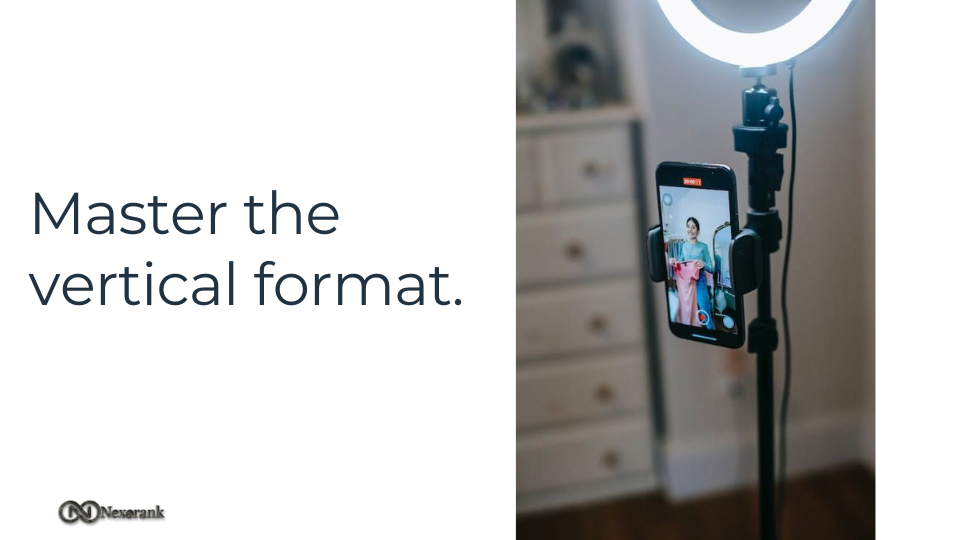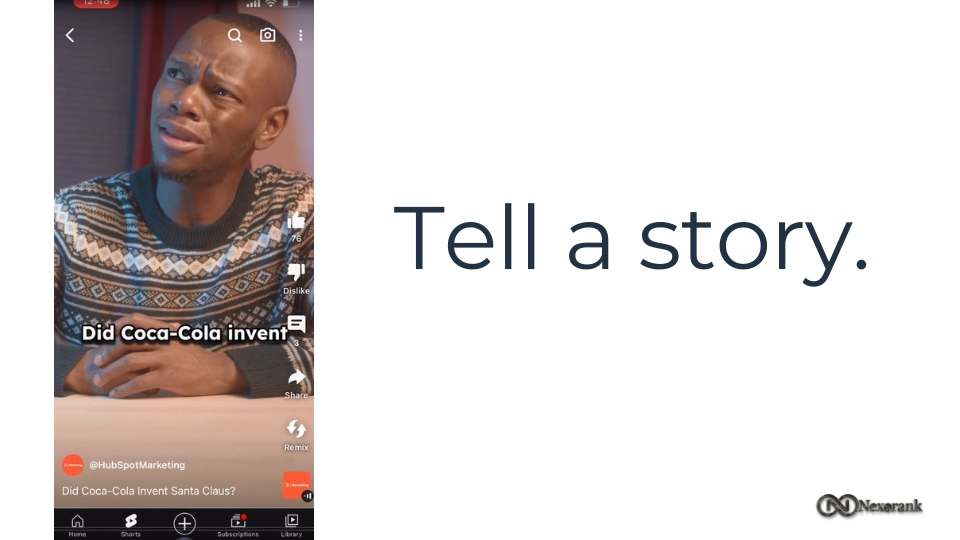So you’re ready to start filming. Let’s go over some of the things to think about that will help make your short-form videos stand out.
Michael Rowe, Nexorank cinematographer & on-camera talent, recommends a structure that begins with a hook and ends with a call to action:
Crafting Compelling Short-Form Video Structure and Filming Techniques
Michael Rowe: More than any of the other aspects of creating short form video, the structure of your video and the story behind it is easily the most important thing. I would consider structuring my videos as a hook, an introduction, a buildup, a climax, and then finally, a CTA, a call-to-action. In my opinion, I think the hook is the absolutely most important part. It can be something visual — a really striking visual. Maybe it’s a picture that you found online. I think it can be an interesting photo that you found online, or a really attractive photo of your product. If you’re an editorial brand, it could be literally anything, any interesting piece of media that you’re able to find about the story that you’re about to talk about. Or rather than being something visual, you can consider your hook in a number of ways from a storytelling perspective. So, one really e ective way to draw people in is using what I like to call the ‘personal to universal hook.’ So I can begin my video by saying, ‘when I was such and such,’ this thing happened to me that made me think about this bigger thing that also happens in the world or to other people, right? So drawing people in with your own experience or an experience that they’ve likely had, and then extrapolating that out to a larger phenomenon that’s going on, You could consider applying that in a variety of di erent ways if you’re even a fashion brand, right? I never felt super confident putting on makeup when I was just learning how, but my brand makes it really easy for people to do that kind of thing. You get the idea.
Enhancing Short-Form Videos with Visual Techniques and Authentic Storytelling

There are a number of other elements you will want to consider when filming. The first is to master the vertical format. Since most short-form videos are filmed vertically, it’s essential to make the most of this format. Frame your subjects in a way that takes advantage of the vertical space, and experiment with di erent perspectives, such as low-angle or high-angle shots, to create dynamic visuals and keep your viewers engaged.
You’ll also want to play with depth, since adding depth to your shots can make your videos more visually interesting. Experiment with foreground and background elements to create a sense of depth, and place your subject in the middle and use objects or scenery to frame them, drawing the viewer’s attention to the center of the frame.
Emphasizing movement is another trick. Keep your viewers captivated by incorporating movement in your videos. Use camera movements like pans, tilts, or even tracking shots to follow your subject. Smooth transitions between shots can also help maintain the flow of your video. Try using match cuts, jump cuts, or creative in-camera transitions like whip pans to seamlessly move from one shot to the next.

And be sure to tell a story. Even in short-form videos, storytelling is crucial. Plan your shots in a way that conveys a narrative or showcases a clear message. Use visual cues, actions, and reactions to make your story engaging and easy to follow.

Don’t forget to capture authentic moment.: Short-form videos thrive on authenticity. Capture candid moments, genuine reactions, and real emotions to create content that resonates with your viewers. Don’t be afraid to show your personality, share behind-the-scenes glimpses, or engage with your audience directly. Experimenting with speed is another element. Playing with di erent speeds can add visual interest to your videos, so try incorporating slow-motion or time-lapse e ects to emphasize certain moments or actions. Most smartphones have built-in features for filming in slow motion or time-lapse mode, making it easy to add these e ects to your short-form videos.
Optimizing for Sound-Off Viewing and Engaging with Platform Features
Since many viewers watch videos with the sound o , be sure to optimize for sound-o viewing. While sound is an essential element of video content, plan your filming so that your videos can still be understood without audio, or be ready to add captions in the editing process.
And finally, remember to engage with the platform’s features. Don’t forget to make use of the features provided by each social media platform. Use stickers, filters, and e ects to add a creative touch to your videos. Explore platform-specific editing tools like TikTok’s green screen e ect or Instagram Reels’ align feature to create more polished and engaging content. While most of these features will be added during the editing process, having a sense ahead of time may help you capture better shots. And there you have it. With these pro tips in your toolbox, you’ll be well-equipped to create captivating short-form videos for social media. So grab your smartphone, and let’s start filming.



















